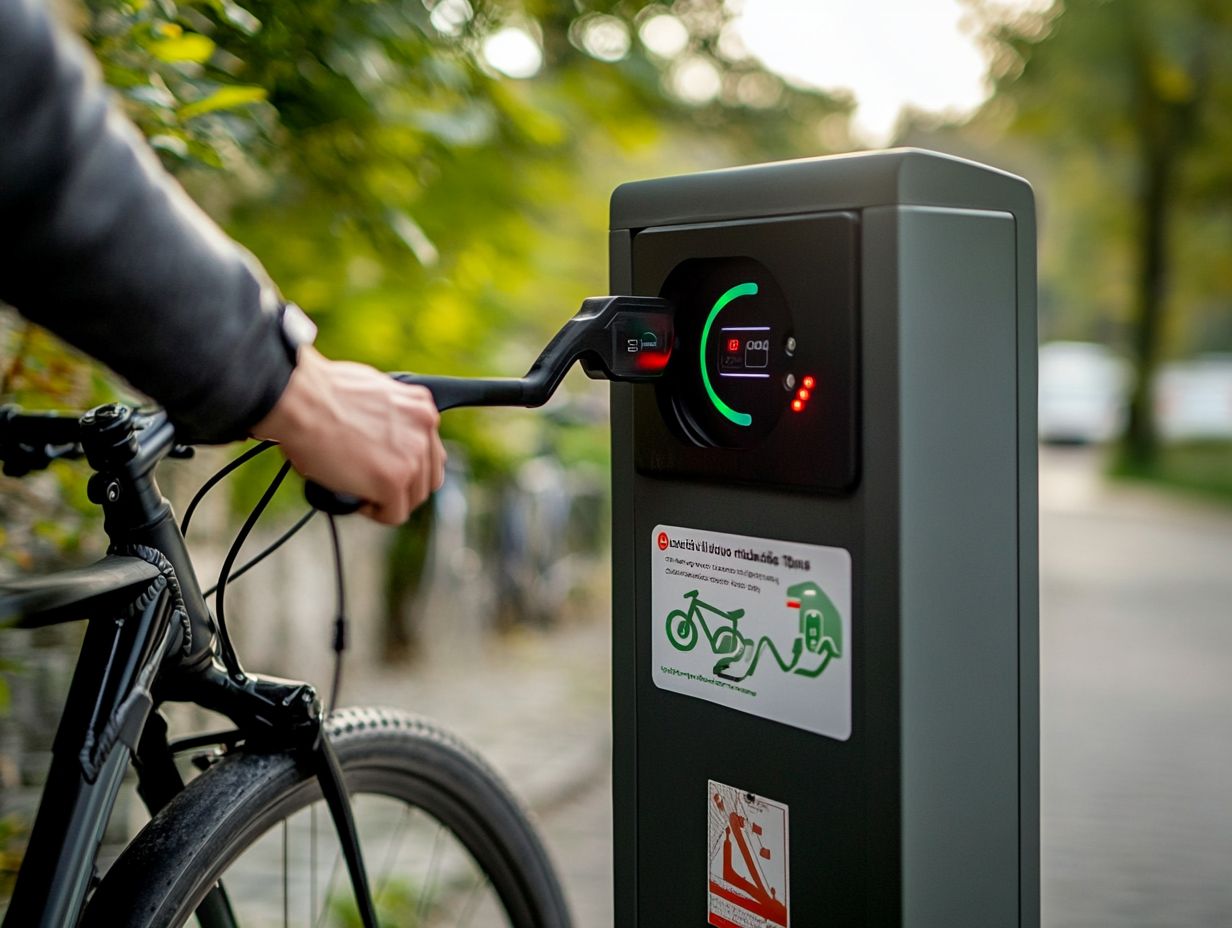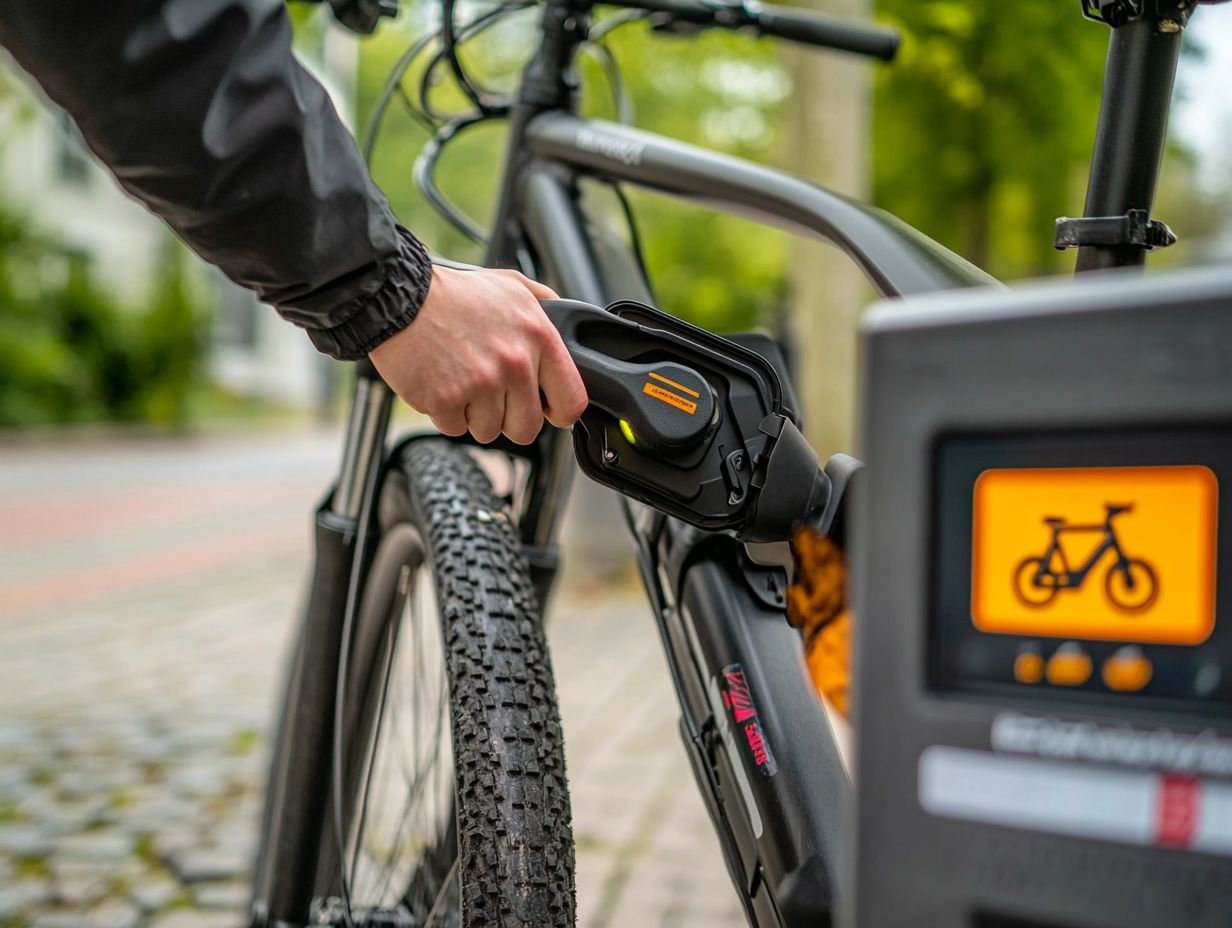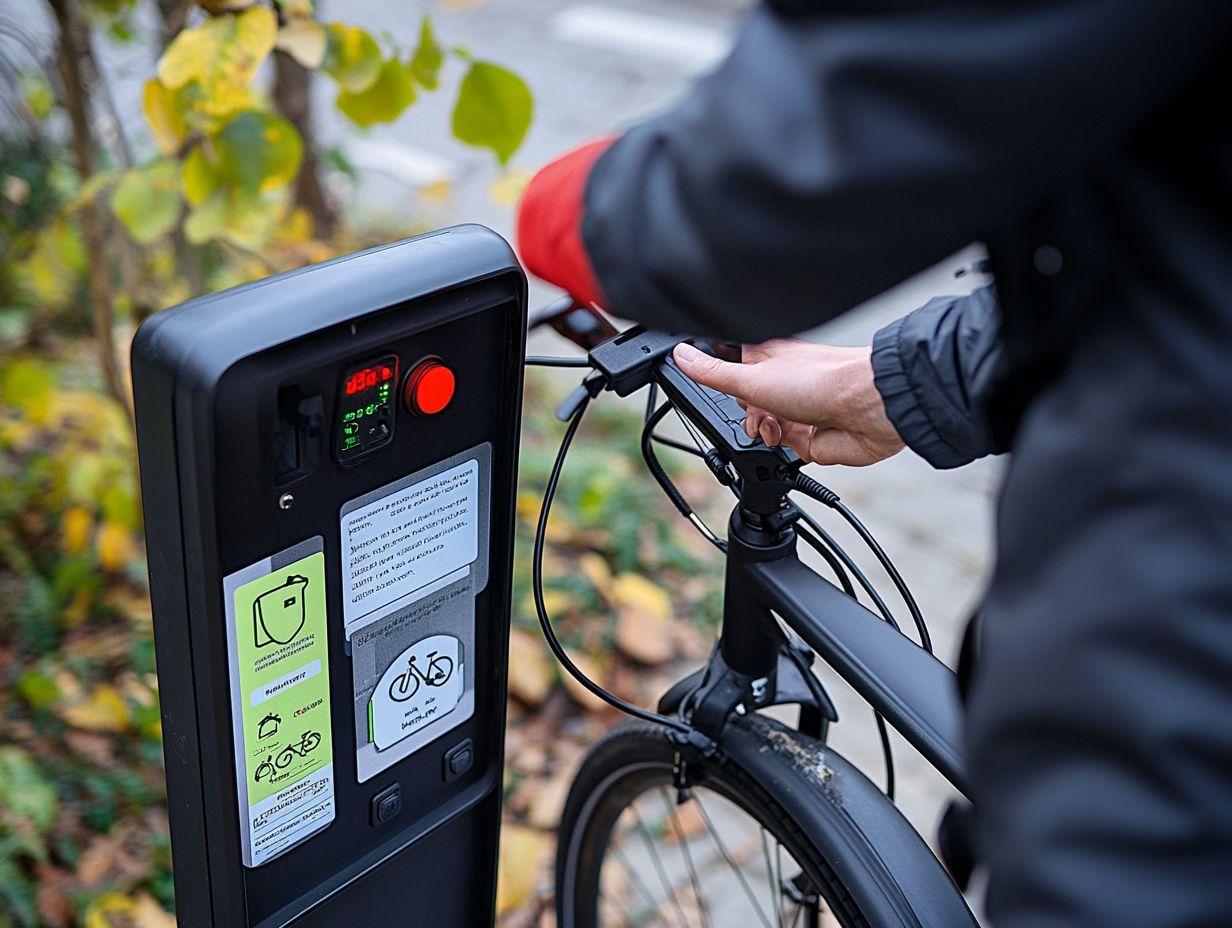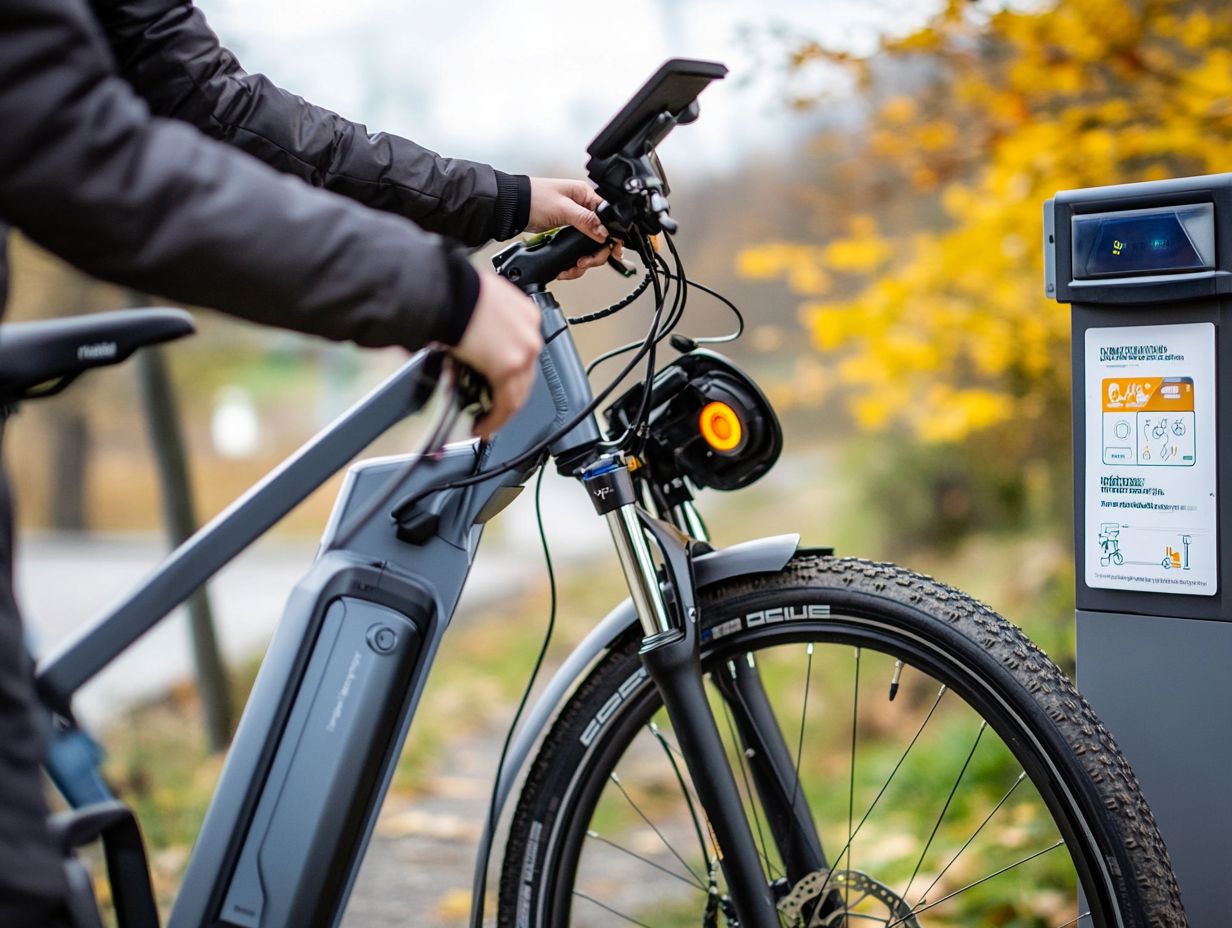What are the Best Practices for E-Bike Charging?
Charging your e-bike transcends the simple act of plugging it in. Grasping the intricacies of e-bike batteries can significantly elevate your riding experience.
This guide delves into the essentials of e-bike charging. It offers best practices for maintaining battery health and optimizing performance, sheds light on common pitfalls to avoid, and explores how to charge while on the move.
With a few insightful tips, you can guarantee that your e-bike remains primed and prepared for every adventure that awaits you.
Contents
- Key Takeaways:
- Understanding E-Bike Charging
- Best Practices for Charging E-Bikes
- Factors Affecting E-Bike Charging
- Charging E-Bikes on the Go
- Common Charging Mistakes to Avoid
- Frequently Asked Questions
- What are the Best Practices for E-Bike Charging?
- Why is it important to use the charger provided by the manufacturer?
- Can I charge my e-bike battery in extreme temperatures?
- Is it safe to leave my e-bike battery charging overnight?
- How often should I charge my e-bike battery?
- What should I do if I notice any issues with my e-bike battery after charging?
Key Takeaways:

- Proper charging techniques are crucial for maintaining the longevity and performance of your e-bike’s battery.
- Optimizing battery life involves understanding external and internal factors that can affect e-bike charging.
- Avoid common charging mistakes and consider options for charging on the go to ensure a smooth and hassle-free e-bike experience.
Understanding E-Bike Charging
Understanding e-bike charging is vital for maximizing both the performance and lifespan of your electric bike’s battery. As e-bikes gain traction in bustling urban environments like NYC, efficient charging practices become increasingly important.
It s not just about plugging in; you also need to know how to charge lithium-ion batteries properly. Recognizing the various factors that influence their capacity and performance during the charging cycle is essential.
With more commuters swapping four wheels for two, grasping the nuances of battery charging is essential to prevent issues and guarantee a safe riding experience.
How E-Bike Batteries Work
E-bike batteries, primarily lithium-ion, harness stored energy to power the electric motor. This significantly enhances your riding experience.
These batteries operate through chemical processes that release energy, making them critical for efficient energy use. The voltage levels play a vital role in determining the speed and range of your e-bike; higher voltage translates to increased power output, enabling quicker acceleration.
The capacity, which indicates how long a battery can run before needing a recharge (measured in ampere-hours (Ah)), dictates how long the battery can maintain this output before it requires a recharge. Regular charging is essential.
Remember, how often you recharge matters don t overlook it to keep your battery in top shape! Understanding these factors allows you to maximize both the efficiency and lifespan of your e-bike’s power source.
Best Practices for Charging E-Bikes
Implementing best practices for charging e-bikes is essential for maintaining battery health, ensuring safety, and prolonging battery life. Regular charging, especially for lithium-ion batteries, not only enhances performance but also prevents damage that could result in hazardous situations, such as fire or toxicity.
By following established charging guidelines, you can optimize your e-bike experience and steer clear of common pitfalls, whether you’re a cycling commuter or a delivery worker. Additionally, consider checking out some tips for maintaining your electric bicycle battery to ensure longevity and performance.
Proper Charging Techniques

Mastering proper charging techniques will boost your e-bike s performance and extend its lifespan! Always use the right voltage and aim for a full charge without succumbing to the temptation of overcharging.
Utilizing compatible chargers is key to maintaining both the efficiency and lifespan of your battery. Different e-bike models may require varying voltage levels; using an unsuitable charger could result in subpar performance or create potentially hazardous situations. For optimal care, consider exploring the best maintenance practices for long-distance electric bicycles.
It’s crucial to understand the risks of improper charging, such as overheating, rapid battery degradation, or even fire hazards. To ensure safe practices, always verify that your charger is certified for your specific e-bike model. For detailed guidance, check out how to properly charge your electric bicycle battery. Avoid charging in extreme temperatures, and keep an eye on the charging session to prevent overcharging, which can drastically shorten your battery’s life.
Optimizing Battery Life
Optimizing the battery life of your e-bike requires a keen understanding of the delicate balance between charging and using your battery, along with proper storage and maintenance practices.
Temperature is a vital factor in battery performance. Extreme heat or cold can drastically impact efficiency and lifespan. By keeping your batteries at moderate temperatures, you ensure optimal chemical reactions, which is essential for their overall health.
Ideally, e-bike batteries should be stored in a cool, dry location, far from direct sunlight, to minimize degradation.
Implementing a regular maintenance routine such as checking for corrosion, cleaning terminals, and ensuring appropriate charge levels will further enhance battery longevity. This allows you to enjoy peak performance over time.
By adhering to these guidelines, you can effectively preserve your battery’s health and maximize its usage.
Factors Affecting E-Bike Charging
Several factors influence e-bike charging, such as temperature variations, voltage levels, and the condition of battery components. Each of these elements is critical for charging efficiency and plays a crucial role in determining both overall performance and charging effectiveness.
External and Internal Factors
External and internal factors are crucial in the charging processes of e-bikes, profoundly impacting both their performance and battery efficiency.
Environmental conditions think nearby heat sources, elevated temperatures, and humidity levels can significantly influence charging speed and the overall longevity of the battery.
For example, excessive heat may lead to overheating, which can deteriorate battery health and compromise the effectiveness of components like inverters and controllers over time, increasing the risk of a damaged battery.
High humidity can cause moisture build-up, leading to corrosion issues.
Grasping these external influences alongside the internal state of the battery, including its age and charge cycles, is vital for optimizing e-bike performance and ensuring a dependable riding experience. For more information, check out this guide on how to optimize battery lifespan in electric bicycles.
Charging E-Bikes on the Go

Charging e-bikes on the go offers you essential convenience, particularly if you’re a cyclist, delivery worker, or urban commuter who depends on public charging stations for your daily transportation needs.
Options for Charging while Riding
Cyclists now have a variety of options for charging their e-bikes while on the go, including portable chargers and public charging stations. Each method has its own set of advantages and disadvantages that can greatly influence your riding experience.
For example, portable chargers enhance your accessibility, allowing you to power up your e-bike anytime and anywhere. However, they often take longer to recharge the battery compared to standard outlets. To ensure optimal performance, it’s important to know how to care for your e-bike battery.
On the flip side, public charging stations offer a quicker charging solution, but their availability can be unpredictable depending on your location, which raises concerns about battery safety in unfamiliar areas. To ensure your e-bike is stored safely, you can explore best practices for e-bike storage. Understanding these factors will enable you to choose the best charging method for your journeys.
Common Charging Mistakes to Avoid
Don’t let common charging mistakes ruin your ride! Safeguard your e-bike’s battery by avoiding common charging mistakes that can jeopardize both safety and longevity.
Engaging in poor practices can lead to performance issues or, worse, damage to the battery itself.
Prioritizing proper charging techniques will ensure that you enjoy a seamless riding experience while maximizing the lifespan of your e-bike s power source.
Start optimizing your e-bike’s battery life today with these simple steps!
Potential Consequences and Solutions
The potential consequences of charging mistakes can be serious. These may include a damaged battery, decreased performance, and serious safety risks like fire.
These issues can manifest in various ways. For example, overheating may lead to battery swelling or, in extreme cases, spontaneous combustion. Imagine a well-known brand whose batteries caught fire due to improper charging practices. This highlights the importance of using certified chargers, which are approved by the device manufacturer for safe use.
To avoid such incidents, it’s crucial to rely on manufacturer-recommended chargers and avoid charging your devices overnight, especially in a natural environment.
Keeping your gadgets away from heat sources and ensuring proper ventilation during charging can significantly reduce these risks. By adopting these practical strategies, you can protect your devices and enhance their performance, ensuring they last longer without compromising safety.
Frequently Asked Questions

What are the Best Practices for E-Bike Charging?
The best practices for e-bike charging include:
- Using the charger provided by the manufacturer as mentioned in the manual.
- Charging the battery at room temperature (around 68-72 F) for optimal performance.
- Plugging the charger directly into a wall outlet instead of using an extension cord.
- Disconnecting the battery from the e-bike before charging.
- Avoiding overcharging by unplugging the battery once it is fully charged for fire safety.
- Storing the battery in a cool, dry place when not in use.
Why is it important to use the charger provided by the manufacturer?
Using the charger provided by the manufacturer ensures compatibility and safety. Using a different charger may damage the battery or create a fire hazard.
Can I charge my e-bike battery in extreme temperatures?
Charging the battery in extreme temperatures is not recommended. High or low temperatures can affect the battery’s performance and lifespan. Aim to charge the battery at room temperature for optimal results.
Is it safe to leave my e-bike battery charging overnight?
Leaving your e-bike battery charging overnight can lead to overcharging. This can damage the battery and decrease its lifespan. Unplug the battery once it is fully charged.
How often should I charge my e-bike battery?
The frequency of charging depends on your usage and the battery’s capacity. For cycling commuters and delivery workers, it is recommended to charge it after every ride or when it reaches 20-30% capacity.
What should I do if I notice any issues with my e-bike battery after charging?
If you notice unusual heat, swelling, or damage to the battery after charging, stop using it immediately. Contact the manufacturer for assistance, such as EVELO, or refer to the safety guide provided by Underwriters Laboratory. Do not continue charging or using the battery if there are any signs of damage.
Stay safe and protect your e-bike by following these best practices!






